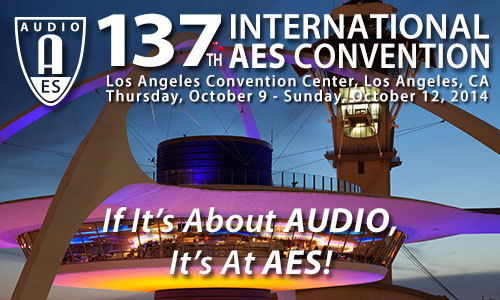
AES Los Angeles 2014
Paper Session P4
P4 - Transducers—Part 1
Thursday, October 9, 2:30 pm — 5:30 pm (Room 309)
Chair:
Joerg Panzer, R&D Team - Salgen, Germany
P4-1 The Dynamics Detection and Processing Method for Preventing Large Displacement Transducer Damage Problem—Yu-Ting Tsai, Feng Chia University - Taichung, Taiwan; Jin H. Huang, Feng Chia University - Taichung, Taiwan
The method for avoiding the large displacement damage problem of the transducer diaphragm is presented in this study. To account for the displacement and supply current, a set of transduction equations with parameters for the receiver is established. The numerical solver is used to obtain the displacement values from the transduction equations of the transducer and then limit the peak of the current and coil velocity by using the dynamics limiter. Once the peak limited process is done, the safe input voltage can be obtained satisfactorily for preventing the impulse damage of displacement. The numerical and experimental results indicate that the proposed method features high efficiency and ability applied in the wide application of transducers.
Convention Paper 9113 (Purchase now)
P4-2 Specifying Xmax for Micro-Speakers and Smart Amplifiers—Géraldine Vignon, NXP - Leuven, Belgium; Shawn Scarlett, NXP - Nijmegen, The Netherlands
Smart amplifiers are a new generation of amplifiers using a real-time feedback loop to ensure the speaker stays within its physical limits, and they are capable of delivering significantly more output power than previously possible. This jump requires the definition of new performance ratings for micro-speakers. The purpose of this paper is to recommend test procedures and methods for the specification of a maximal speaker-membrane excursion (Xmax) suitable for an application that uses a smart amplifier. The proposed set of criteria to characterize this usable excursion should allow micro-speaker vendors to provide optimized and reliable solutions to their customers.
Convention Paper 9114 (Purchase now)
P4-3 Comparative Study of Si and SiC MOSFET for High Voltage Class D Audio Amplifiers—Dennis Nielsen, Technical University of Denmark - Kgs. Lyngby, Denmark; Arnold Knott, Technical University of Denmark - Kgs. Lyngby, Denmark; Michael A. E. Andersen, Technical University of Denmark - Kgs. Lyngby, Denmark
Silicon (Si) Metal–Oxide–Semiconductor Field-Effect Transistors (MOSFETs) are traditionally utilized in class D audio amplifiers. It has been proposed to replace the traditional inefficient electrodynamic transducer with the electrostatic transducer. This imposes new high voltage requirements on the MOSFETs of class D amplifiers and significantly reduces the selection of suitable MOSFETs. As a consequence it is investigated if Silicon-Carbide (SiC) MOSFETs could represent a valid alternative. The theory of pulse timing errors are revisited for the application of high voltage and capacitive loaded class D amplifiers. It is shown that SiC MOSFETs can compete with Si MOSFETs in terms of THD. Validation is done using calculations and a ± 500 V amplifier driving a 100 nF load. THD+N below 0.3% is reported.
Convention Paper 9115 (Purchase now)
P4-4 Adaptive Stabilization of Electro-Dynamical Transducers—Wolfgang Klippel, Klippel GmbH - Dresden, Germany
A new control technique for electro-dynamical transducer is presented that stabilizes the voice coil position, compensates for nonlinear distortion, and generates a desired transfer response by preprocessing the electrical input signal. The control law is derived from transducer modeling using lumped elements and identifies all free parameters of the model by monitoring the electrical signals at the transducer terminals. The control system stays operative for any stimulus including music and other audio signals. The active stabilization is important for small loudspeakers generating the acoustical output at maximum efficiency.
Convention Paper 9116 (Purchase now)
P4-5 Retrofitting a Complex, Safety-Critical PA System for Periodic Testing—Gregor Schmidle, NTi Audio AG - Schaan, Liechtenstein; Philipp Schwizer, NTi Audio AG - Schaan, Liechtenstein; Winfried Häns, Kernkraftwerk Gundremmingen GmbH - Gundremmingen, Germany
This paper describes considerations and the implementation of retrofitting a fully-automated procedure, for testing a public address system, into a safety-critical environment (a nuclear power plant). There are over 4000 loudspeakers, about 200 amplifiers as well as various alarm-signal generators that need to be tested every day within a few minutes. Additionally, all command room microphones are checked using a semi-automated procedure. The procedures were designed and configured to not only reliably detect single defective components, but also to not produce any false alarms.
Convention Paper 9117 (Purchase now)
P4-6 The Correlation between Distortion Audibility and Listener Preference in Headphones—Steve Temme, Listen, Inc. - Boston, MA, USA; Sean Olive, Harman International - Northridge, CA, USA; Steve Tatarunis, Listen Inc. - Boston, MA, USA; Todd Welti, Harman International - Northridge, CA, USA; Elisabeth McMullin, Harman International - Northridge, CA USA
It is well-known that the frequency response of loudspeakers and headphones has a dramatic impact on sound quality and listener preference, but what role does distortion have on perceived sound quality? To answer this question, five popular headphones with varying degrees of distortion were selected and equalized to the same frequency response. Trained listeners compared them subjectively using music as the test signal, and the distortion of each headphone was measured objectively using a well-known commercial audio test system. The correlation between subjective listener preference and objective distortion measurement is discussed.
Convention Paper 9118 (Purchase now)
